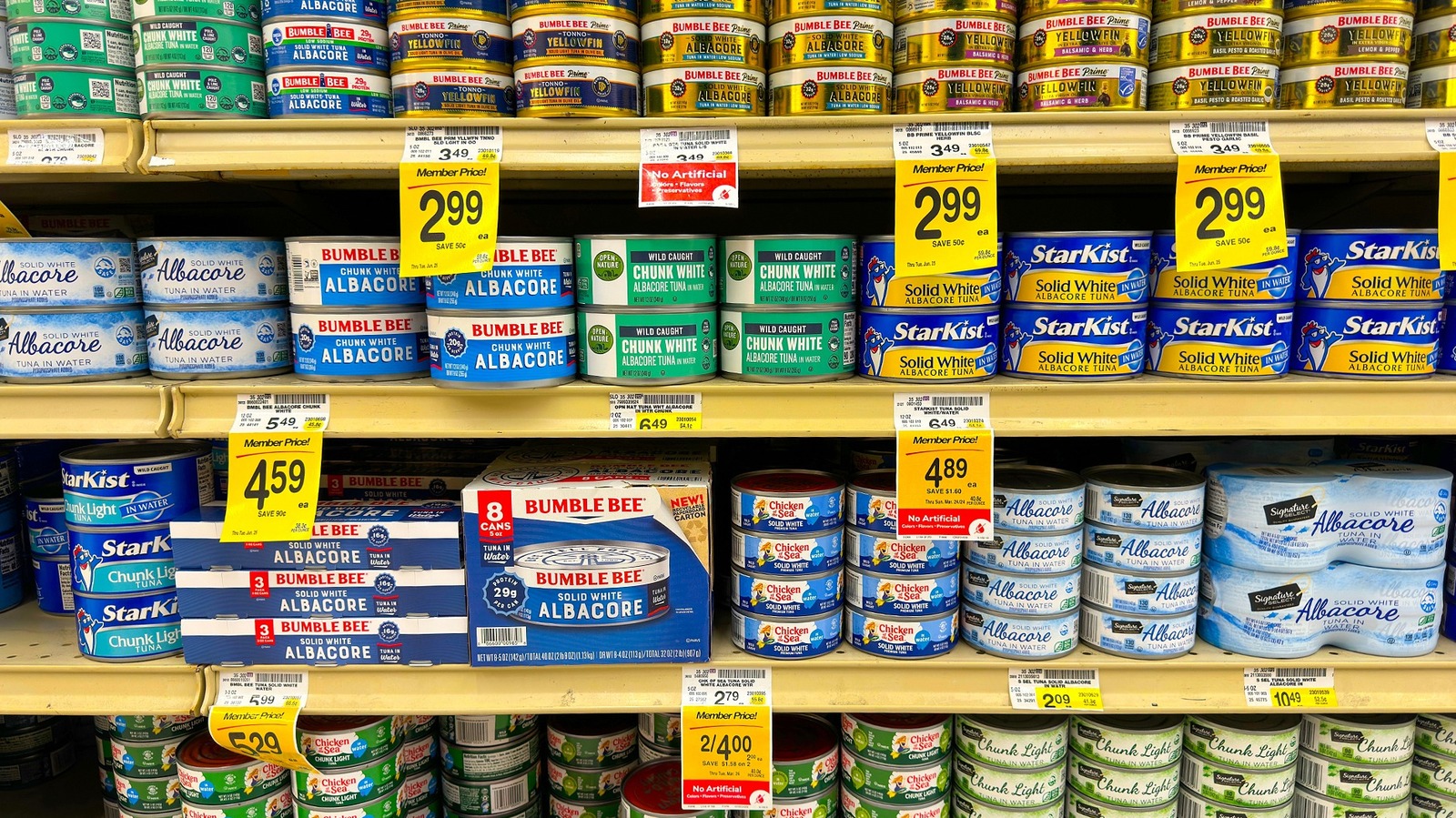
Known for its versatility, canned tuna is one of those basic pantry staples that can be used to spruce up a casserole, add bits of freshness to an otherwise mundane salad, or be eaten as a protein-packed snack right from the can. But with so many options, how do you know which is the best choice? From oil-packed to water-packed and skipjack to albacore, knowing a bit about the different varieties makes it easier to make the right selection. There are several types of popular canned tuna, including skipjack, albacore, bluefin, bigeye, and yellowfin.
Skipjack is considered one of the most abundant tuna species. It's known for having darker meat and a stronger flavor. Albacore tuna (commonly referred to as white tuna) has a mild flavor and firm texture.

Bluefin also has a firm texture. It's known for its nutritional content; it's high in protein, as well as nutrients like niacin, selenium, B vitamins, and omega-3 fatty acids. Bigeye tuna is traditionally bright pink in color and is known for its high-fat content, which contributes to its robust flavor.
Meanwhile, yellowfin is also known for its pink color and mild flavor. But aside from the different varieties of canned tuna, there's a lot you should look out for when buying some (in regards to nutritional content, sustainability, mercury levels, packaging, and more). Let's take a closer look.
1. Check the label for terms like white or light and chunky or solid You can expect to find white and light variations of canned tuna lining grocery store shelves. "White" is a term that usually refers to albacore tuna .
And just as the name implies, it appears whiter in color than the "light" variety of canned tuna (which often ranges somewhere between tan and pink). When it comes to taste, white tuna is often described as being milder than its light counterpart, which is sometimes described as "fishy." Which one works best comes down to preference and usage.
If you don't want the flavor of your canned tuna to overpower the dish, opt for the white tuna. If you want a more distinctive and pronounced taste, consider reaching for the light variety. In addition to white and light, tuna also comes in various sizes, including chunk and solid.
In this case, size refers to the size of tuna pieces in each can. For instance, "solid" indicates that there are bigger, firmer pieces of fish. The label "chunk" means that the pieces of tuna are smaller.
Certain types of tuna — such as yellowfin and albacore — lend themselves to solid packing because the fish they come from are larger in size. Conversely, skipjack tuna is a smaller fish, so it's typically available in the chunkier style. 2.
Pay attention to whether your tuna comes packed in oil or water Canned tuna is often packed in water or oil (along with other ingredients) to preserve the tender fish until it is ready for consumption. The liquid it's packed in will impact the flavor of your canned tuna. For instance, water-packed tuna is said to have a milder flavor, because this liquid dilutes the natural juices of the fish.
Meanwhile, oil-packed tuna is typically packed in soy, vegetable, or olive oil and is known for its more robust flavor. This is because the oil essentially traps the natural flavors of the fish. However, within each oil-packed can are more calories and fat than its water-packed counterpart, so be sure to take this into consideration.
Also, both varieties are often combined with salt to maintain freshness and add flavor. Due to the differences between water-packed and oil-packed tuna, one must know when to reach for each type. Oil-packed tuna lends itself to tuna salad and pasta, where it can enhance the dish by acting as its own fat-filled dressing.
Its moisture also makes it a good choice for making tuna sandwiches or eating it straight from the can. Meanwhile, water-packed tuna dresses up a tuna noodle casserole or a dip better. This type of tuna ensures there are no competing flavors when creating a more flavorful sauce in these types of recipes.
Its firmer texture also makes it a good choice for tuna patties . 3. Learn how to spot sustainably sourced tuna Certain tuna fishing methods (that involve setting net traps) may inadvertently drown dolphins and other large fish.
Because of this, some people choose to purchase canned tuna sourced using methods that have less of a negative impact on other animals, and are therefore more sustainable. If you want to buy more sustainably sourced tuna, opt for cans with labels such as pole-and-line-caught, pole-caught, troll-caught, FAD-free, free school, and school-caught. These terms refer to tuna fishing practices in which there is a low chance of accidentally trapping other fish.
These practices also help avoid disturbing fragile marine habitats, such as coral. You can also look for environmentally friendly canned tuna by seeking out the blue certification stamp of the Marine Stewardship Council (an organization dedicated to fishing sustainability). This label means the fish is coming from a company that meets the Marine Stewardship Council's high standards.
4. Know the mercury levels associated with different types of canned tuna Some types of canned tuna contain high levels of mercury, which can have negative health impacts if consumed too often. It's not only important to consume canned tuna moderately, but also informatively (as mercury levels vary with different species).
For instance, canned skipjack tuna has some of the lowest mercury levels (0.13 parts per million), while canned albacore and yellowfin tie for the second lowest mercury levels (0.35 parts per million), according to the Environmental Protection Agency .
A rule of thumb says to consider the size of the fish the canned tuna is coming from. The bigger the fish, well, the more mercury it's likely to contain. Why does all this talk about mercury matter? Because excess mercury consumption can lead to possible symptoms of memory loss, irritability, and tingling in the body.
Additionally, it can have lasting effects on the senses of taste, vision, and smell, says Michael O'Neill, an internal medicine specialist, told Hartford Healthcare . Pregnant women and children are particularly vulnerable to its lingering effects. For this reason, the United States Food and Drug Administration recommends limiting consumption to 3 to 5 ounces of tuna, no more than two to three times per week for adults and twice per week for children.
5. Avoid cans that are especially high in sodium When selecting a canned tuna, look to the back of the can to determine its sodium content (something important to consider). Diets high in sodium are known to cause high blood pressure, cardiovascular diseases, gastric cancer, obesity, osteoporosis, Ménière's disease, and kidney disease, according to the World Health Organization .
And with the U.S. Food and Drug Administration's recommended daily value of 2,300 milligrams, it's important to scrutinize the contents of a can before you put it in your cart.
Water-packed cans on average contain around 219 milligrams of sodium per serving, while oil-packed cans usually contain more, at 416 milligrams of sodium per serving. Additionally, albacore tuna tends to have a higher sodium content than most types of canned tuna, at around 250 milligrams per serving. While that's not near the daily limit for sodium, it can add up if you're consuming canned tuna too often or combining it with salty ingredients when eating it.
To select a low-sodium canned tuna, opt for low-sodium or no-salt-added varieties, such as StarKist Selects' Solid White Albacore Tuna in Water , which contains 65 milligrams of sodium per 4.5-ounce can. 6.
Don't purchase cans with dents or other signs of damage It's not just for cosmetic purposes that your mother instructed you to return cans to the shelf in the grocery store if they were dented. Dents can lead to cracks, which can introduce bacteria or mold to the foods inside those cans. So, steer clear of bulges, dents, rust, and other imperfections on your tuna cans.
These blemishes can signify that the meat could have been potentially contaminated or compromised by the bacteria Clostridium botulinum, a type of food poisoning that is known to cause respiratory and muscular paralysis, according to the World Health Organization . And no one wants to eat food that is unsafe. Also, take a close look at the can's expiration date.
While some people think cans inevitably offer an eternal shelf life, it's simply not the case. When it comes to canned tuna, the USDA recommends a shelf life of between two and five years. Also, there's nothing that beats good old common sense.
If there's mold in the can, pitch it immediately. After all, that's one of the great things about tuna — it's friendly on the wallet. So do yourself a favor and pitch any cans that just don't look right.
Your wallet might be lighter, but your health will thank you..















